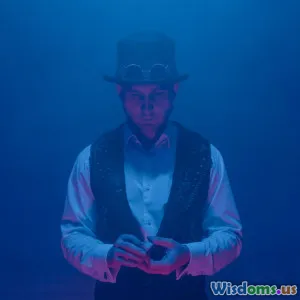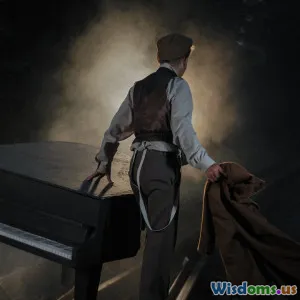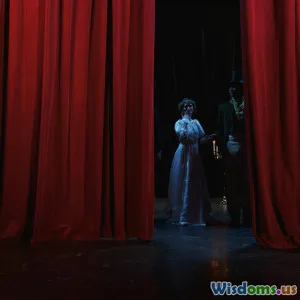
Building Suspense Spotlight Techniques in Dramatic Magic Revealed
9 min read Unlock the secrets of suspense in dramatic magic with spotlight techniques that captivate and mystify audiences. (0 Reviews)
Building Suspense Spotlight Techniques in Dramatic Magic Revealed
Magic and stage mysteries captivate audiences by evoking awe, surprise, and curiosity. Central to this enchantment is suspense — the tension that makes the impossible feel tangible and the reveal unforgettable. One of the most effective tools to heighten this suspense in dramatic magic is the strategic use of spotlight techniques. In this article, we’ll unpack how lighting, especially spotlighting, creates suspense, the psychology behind it, and practical ways magicians can harness it to elevate their performances.
Introduction: Why Suspense Transforms Magic
Suspense is the invisible tether between the magician and spectator. When properly built, it draws viewers deeper into the illusion, keeping them at the edge of their seats. Renowned magician Harry Houdini himself acknowledged that beyond intricate tricks, "The real magic lies in the drama you build around the performance."
Spotlight techniques are not just technical lighting tricks; they are storytelling devices that guide audience focus, shape mood, and manipulate anticipation. Think of suspense as a story unfolding on stage, and the spotlight as the narrator’s voice guiding the listener’s emotional journey.
The Role of Spotlight in Building Suspense
Guiding Audience Attention
The human eye and brain crave guidance. With distractions everywhere, a directed beam of light cues the audience where to look, limiting their scope and sharpening focus. Magician David Copperfield often uses a narrow spotlight focused solely on his hands at critical moments to magnify attention on the unexplained movement, enhancing the mystery.
Creating Contrast and Isolation
Spotlights create stark contrasts between lit and shadowed areas on stage. This isolation can make an object or performer appear vulnerable or mysterious, playing to human fears and wonder. For example, in the classic illusion "Levitation," a magician may be bathed in intense spotlight while the stage around fades to darkness, emphasizing the surreal floating effect and keeping the audience’s focus absolutely centered.
Manipulating Time Perception
Suspense is often tied to stretched moments — brief pauses or slow reveals that keep audiences anticipating the next moment. By dimming ambient lights and using a spotlight to spotlight to create a "time bubble" around the performer or object, magicians subtly alter the audience’s perception of time, making seconds feel like minutes, an effect supported by cognitive psychology research on attention and arousal.
Spotlight Techniques That Build Suspense: Practical Approaches
1. Narrow Beam Focus
Constricting the lighting to a small, focused spot pulls the audience’s eyes to exactly what matters. This method is effective during moments of preparation before the main reveal, heightening tension. In Illusionist Derren Brown’s performances, a tight spotlight often zeroes in on an envelope or object purported to hold a secret, locking the audience’s curiosity before unveiling.
2. Moving Spotlights
A slowly moving spotlight can be a metaphor for uncertainty and searching. When used to traverse the stage or an object in darkness, it builds anticipation, mimicking the act of a detective inspecting clues. This dynamic tension primes the audience emotionally for the climax.
3. Silhouette Effects
Positioning the magician in front of a bright background with a spotlight from behind creates silhouette illusions, amplifying mystery and otherworldliness. It reminds audiences of shadows, unknown forms, and hidden secrets, stirring primal curiosity.
4. Strategic Fade-Ins and Fade-Outs
Gradual transitions in light intensity can simulate entrance and exit of suspense. Dim the spotlight slowly before a profound moment or bring it back up to sharply reveal an object or performer. This technique controls emotional peaks and valleys.
5. Color Temperature and Intensity
Changing the color of the spotlight—from cold blues that evoke eeriness to warm reds suggesting danger or passion—can influence the audience’s subconscious emotional state, enhancing suspense. Slightly dimmed intensity can create intimacy, too, making the audience feel part of a secret.
Real-World Insights and Examples
-
Penn & Teller’s use of spotlighting: Their trick “The Bullet Catch” incorporates tight spotlights to isolate the trajectory of the bullet, escalating tension by visually emphasizing the imminent danger juxtaposed with the contained risk.
-
Cirque du Soleil’s Mystère utilizes spotlight shifts not only on performers but props, crafting suspense layered in dance and acrobatics. Lighting directors work closely with magicians to weave visual storytelling into every act.
-
Scientific Insight: Studies in cognitive neuroscience, such as the work by Dr. Stephen Macknik on visual attention, indicate that a spotlight-like focus draws neuronal resources more intensively, making the brain more primed for surprise or delight—key to successful suspense in magic.
How to Incorporate These Techniques as a Magician
-
Test Timing Carefully: Use trial runs to understand how your audience reacts to different spotlight cues.
-
Collaborate with Lighting Professionals: If possible, team up with lighting designers who understand theatrical spotlight manipulation nuances.
-
Rehearse Movements Under Light: Your stage positions relative to the spotlight can change the effect entirely; practice until your movements and lighting sync seamlessly.
-
Explore Color Filters: Experiment to find your style, whether it's cold, stark suspense or warm immersion.
-
Use Lighting as a Dramatic Partner: Think of your spotlight as a co-performer—work with it, not just around it.
Conclusion: Elevate Your Magic Through Spotlight Suspense
Building suspense through spotlight techniques is more than a lighting trick—it is an essential storytelling device woven into the fabric of dramatic magic. From refining audience focus and enhancing contrast to manipulating tempo and emotion, spotlighting is an art that transforms illusions into gripping experiences.
Magicians who master this craft tap into psychological principles of attention and anticipation that transcend mere trickery. They invite spectators into a moment suspended in time, making the magic not just seen, but felt. If you want to craft memorable performances that linger in minds long after the curtain falls, embracing suspense-building spotlight techniques is an indispensable step.
Armed with these insights, magicians and performers alike can illuminate not just the stage, but the hearts and imaginations of their audiences.
“Lighting makes the moment memorable. Master it, and you master magic.” – Anonymous Theater Lighting Designer
Rate the Post
User Reviews
Popular Posts



















